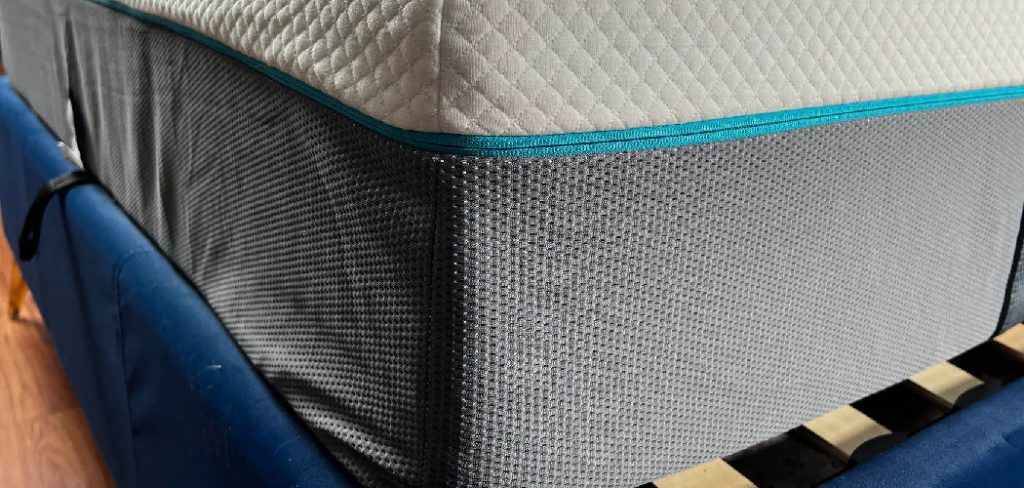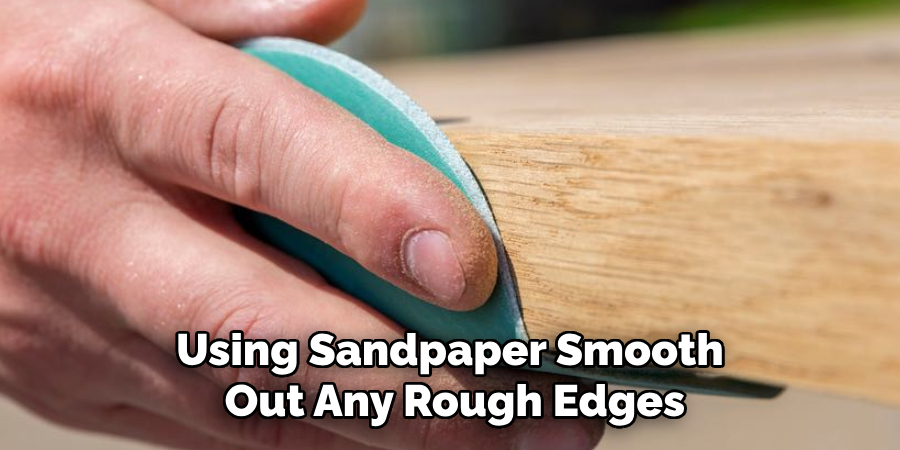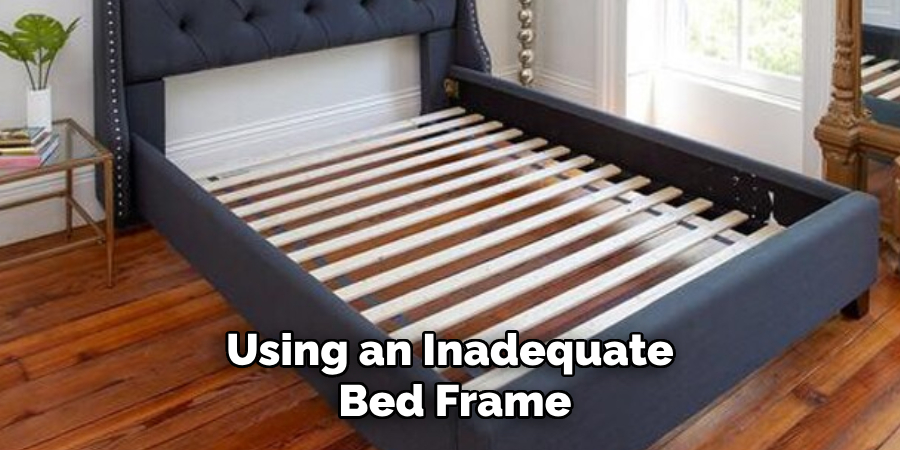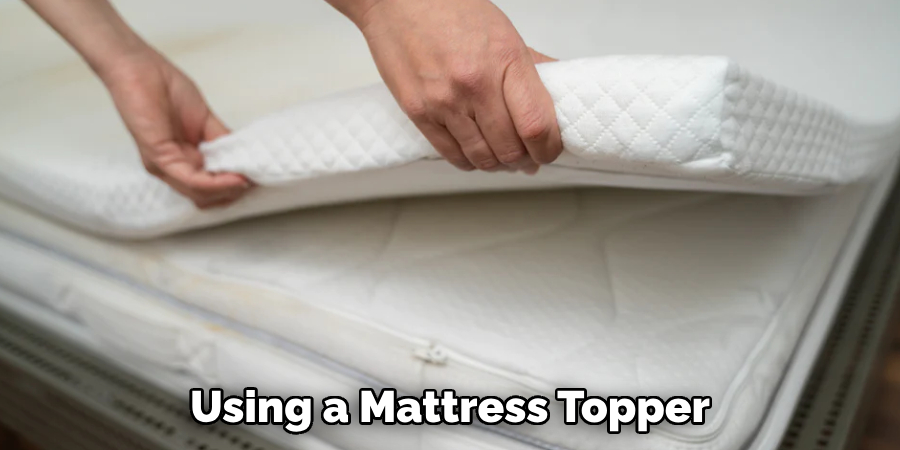If you’re experiencing a sagging mattress, you might be wondering why you should consider using plywood to fix it. After all, there are countless other options out there for mattress support such as box springs and bed frames. However, using plywood is not only a cost-effective solution but also has its own unique benefits.

The main advantage of using plywood to fix a sagging mattress is its ability to provide evenly distributed support. Unlike box springs or other support options, plywood does not have any gaps or spaces that can lead to uneven support. This ensures that your entire mattress receives equal support, which can help alleviate the sagging and improve your overall sleep experience. Read this blog post to learn how to fix a sagging mattress with plywood.
Step-by-step Instructions for How to Fix a Sagging Mattress With Plywood
Step 1: Inspect the Mattress
Before you begin to fix your sagging mattress with plywood, it’s important to inspect the mattress first. Look for any visible sagging or indentations on the surface of the mattress. This will help you determine where the plywood should be placed.
Step 2: Gather Your Materials
To fix a sagging mattress with plywood, you will need a few materials including:
- Measuring tape
- Plywood (at least half an inch thick)
- Saw
- Sandpaper
- Screws
- Screwdriver
Step 3: Measure the Mattress
Using a measuring tape, measure the length and width of your mattress. This will ensure that you cut the plywood to the correct size. Using a saw, cut the plywood to the same size as your mattress. Make sure to wear protective gear while using the saw.
Step 4: Sand The Plywood
Using sandpaper, smooth out any rough edges or splinters on the plywood. This will prevent any damage to your mattress. Once you have prepared the plywood, place it on top of your sagging mattress. Make sure it is centered and covers all areas of sagging.

Step 5: Secure the Plywood
Using screws and a screwdriver, secure the plywood onto the bed frame. Make sure the screws are evenly spaced out along the edges of the plywood. Lie down on the mattress and see if you can feel a difference. If there is still some sagging, you may need to add more plywood or adjust the placement.
Step 6: Add an Extra Layer of Protection
To prevent any damage to your mattress, you can place a thin layer of foam or a mattress pad on top of the plywood before putting on your sheets. Regularly inspect and rotate your mattress to prevent further sagging. You can also repeat this process if needed in the future.
Safety Tips for How to Fix a Sagging Mattress With Plywood
- Use proper lifting techniques when handling the plywood to prevent strain or injury.
- Wear protective gloves while handling the plywood to protect your hands from splinters.
- Make sure the mattress is properly supported and stable before adding any extra layers.
- Avoid using damaged or sharp pieces of plywood, as they could cause harm to both you and the mattress.
- Take measurements beforehand to ensure that the plywood fits properly on top of your mattress.
- If you are not comfortable with DIY methods, consider hiring a professional for assistance.
- Keep children and pets away from the area while working on fixing the sagging mattress.

By following these safety tips, you can successfully fix a sagging mattress with plywood without any accidents or injuries. Remember to always prioritize your safety and take necessary precautions while handling materials and tools.
What Causes a Mattress to Sag?
A sagging mattress is a common problem that many people face. It can be frustrating and uncomfortable to sleep on a mattress that doesn’t provide proper support. There are several factors that can contribute to a sagging mattress, such as:
- Age: As mattresses age, they naturally start to lose their shape and become less supportive.
- Weight distribution: If you or your partner tends to sleep in one spot more than others, it can cause uneven weight distribution and lead to sagging.
- Poor quality materials: A low-quality mattress may not have enough support or durability, leading to premature sagging.
- Improper bed frame or foundation: Using an inadequate bed frame or foundation can also cause a mattress to sag over time.
- Lack of maintenance: Not rotating your mattress regularly or not using a mattress protector can also contribute to sagging.

By understanding the causes of a sagging mattress, you can take steps to prevent it from happening or fix it if it’s already an issue.
Are There Any Risks or Downsides to Using Plywood on Your Mattress?
While using plywood to fix a sagging mattress is a common and affordable solution, there are some potential risks and downsides to consider. These include:
- Reduced ventilation: Plywood can restrict air flow through your mattress, leading to increased heat retention. This may make your sleep environment uncomfortable.
- Potential for mold or mildew growth: Without proper air circulation, moisture can get trapped between the plywood and mattress which can promote mold or mildew growth.
- Uneven support: If not cut and placed properly, plywood can actually worsen the unevenness of a sagging mattress by creating high spots or dips.
It’s important to carefully assess these risks before deciding to use plywood as a fix for your sagging mattress.
Are There Any Alternative Methods for Fixing a Sagging Mattress Besides Using Plywood?
Sagging mattresses can be a major nuisance, causing discomfort and disrupting your quality of sleep. One common solution to this problem is using plywood to provide additional support to the mattress. However, not everyone may have access to or want to use plywood for various reasons.
1. Mattress Toppers
One option is using a mattress topper, which is essentially an extra layer of cushioning that goes on top of your existing mattress. This can help improve the overall comfort and support of the mattress, potentially reducing or eliminating sagging in certain areas. However, this may not completely fix the issue if the mattress is already significantly sagging.

2. Mattress Pads
Similar to mattress toppers, mattress pads can also provide an extra layer of cushioning for your mattress. However, they are usually thinner and don’t offer as much support as a topper. They may be more suitable for minor sagging issues or as a temporary fix until you can properly address the problem.
3. Reinforced Support Beams
If your bed frame has wooden slats that are causing the sagging, you can reinforce them with additional support beams placed across them. This can help distribute weight more evenly and prevent the slats from bowing under pressure.
4. Replacing Old Springs
For mattresses with spring systems, it’s possible that the springs have worn out and are no longer providing adequate support. In this case, replacing old springs may be a more effective solution than using plywood to fix sagging.
5. Flipping or Rotating the Mattress
In some cases, simply flipping your mattress over or rotating it regularly can help prevent sagging by distributing weight more evenly. This is especially helpful for pillow-top mattresses that cannot be flipped but can still be rotated.
6. Professional Repair Services
If none of the above options seem to work, consider contacting a professional for repair services. They may offer more specialized solutions based on the type and severity of sagging in your specific mattress.
Ultimately, while using plywood may be a cost-effective solution for fixing a sagging mattress, it’s not the only option available. Consider these alternative methods or consult with a professional to find the best solution for your specific needs and mattress type.

How Often Should You Check and Readjust the Plywood Support Under Your Mattress?
One question that often arises when considering using plywood to fix a sagging mattress is how often the support should be checked and readjusted. This is important to consider, as improper or infrequent maintenance can lead to further issues with your bed. Firstly, it is recommended to check and adjust the plywood support every 6-12 months. This timeframe may vary depending on the size of your mattress, the weight being put on it, and any changes in your sleeping habits or body weight.
Regularly checking and readjusting the plywood support will help prevent any potential damage to your mattress and ensure that it continues to provide adequate comfort and support. In addition, if you notice any signs of sagging or discomfort in your mattress before the recommended timeframe, it is important to address the issue immediately. This may mean checking and readjusting the plywood support more frequently or considering other solutions such as replacing your mattress.
Are There Different Types of Plywood That Work Better for This Method?
Yes, there are different types of plywood that can be used to fix a sagging mattress. The most commonly recommended type is 3/4 inch thick plywood, as it provides enough support while also being thin enough to fit between the mattress and box spring. However, depending on the severity of the sagging and the weight of the mattress, other types of plywood may be more suitable. Thicker plywood such as 1 inch or 1 1/2 inches may be needed for heavier mattresses, while thinner plywood like 1/2 inch may work for lighter ones.
Another factor to consider is the type of wood used in the plywood. Softwood plywood, made from trees like pine or spruce, is generally less expensive but may not be as durable as hardwood plywood. Hardwood plywood, made from trees like oak or maple, is stronger and more resistant to bending and warping. Ultimately, the type of plywood you choose should depend on your specific needs and budget. It’s important to carefully measure your mattress and determine the level of support needed before purchasing any plywood for this method. Additionally, make sure to choose a high-quality plywood with minimal defects such as knots or cracks for best results.
Conclusion
In conclusion, using plywood to fix a sagging mattress is an effective and affordable solution that can help extend the lifespan of your mattress. By addressing the root cause of the problem, which is usually a worn-out support system, you can avoid potential health issues such as back pain and discomfort.
However, it is important to note that this method may not be suitable for all types of mattresses. It is best to consult with a professional before attempting to fix a sagging mattress with plywood. Moreover, regular maintenance and rotation of your mattress can also prevent it from sagging in the first place. I hope this article has been beneficial for learning how to fix a sagging mattress with plywood. Make Sure the precautionary measures are followed chronologically.
